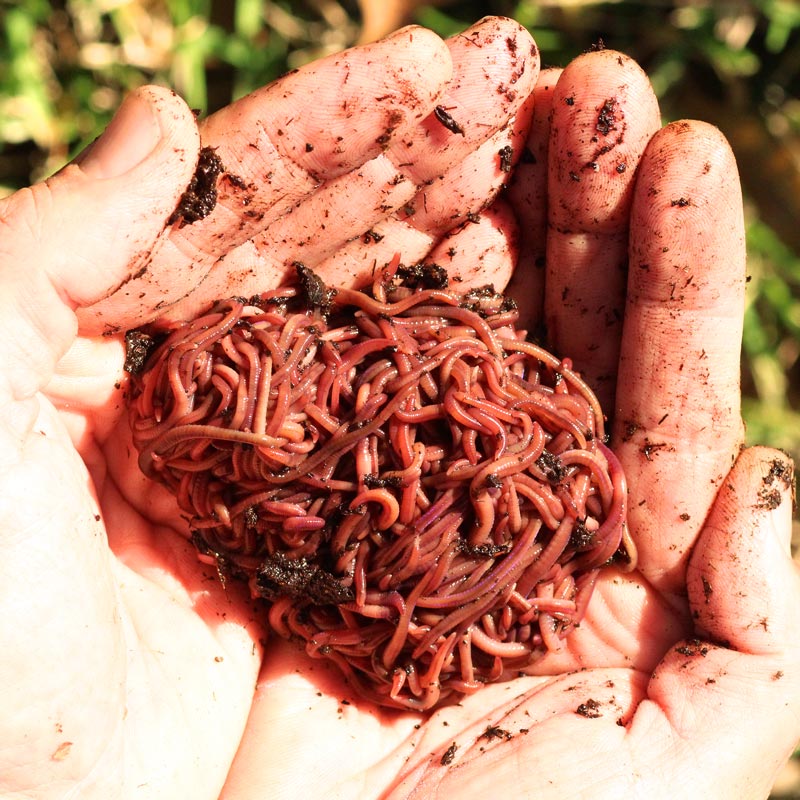Organic Composting with Red Wiggler Worms - Boost Your Garden's Growth
Organic Composting with Red Wiggler Worms - Boost Your Garden's Growth
Blog Article
Maximizing the Conveniences of Red Wiggler Worms: A Comprehensive Handbook for Home Gardeners and Urban Farmers
In the world of sustainable horticulture techniques, red wiggler worms stand as unhonored heroes, quietly transforming organic waste right into nutrient-rich castings that can work marvels for soil health and wellness. By exploring the details of exactly how to efficiently care for and take full advantage of the advantages of red wiggler worms, people can unlock a wealth of chances for enhancing the sustainability and efficiency of their horticulture undertakings.
Recognizing Red Wiggler Worms
Red Wiggler worms, renowned for their efficient composting capacities, are a varieties of earthworms commonly made use of in vermiculture techniques. These worms, scientifically known as Eisenia fetida, thrive in decaying organic material, making them suitable prospects for composting.
One trick feature of Red Wiggler worms is their reproductive rate. These hermaphroditic creatures possess both female and male reproductive organs, enabling them to replicate quickly under positive problems. A mature Red Wiggler can produce multiple offspring in a short period, making certain a steady population within a composting system.

Establishing a Worm Bin
When developing a worm bin for vermiculture objectives, proper prep work and attention to information are necessary for developing a favorable environment for Red Wiggler worms. Begin by selecting an appropriate container for your worm container. This can be a plastic or wooden container with a cover to keep moisture degrees and secure the worms from light. Make certain that the bin has drain holes at the base to avoid waterlogging.

Area the worm bin in an amazing, dark place far from direct sunlight and severe temperature levels. Regularly keep an eye on the wetness degrees, including water if the bed linen really feels completely dry or flaky. Feed the worms a balanced diet of vegetables and fruit scraps, preventing citrus fruits, onions, and spicy foods. By complying with these actions, you can set up a growing worm container that will efficiently process organic waste right into nutrient-rich vermicompost for your yard.
Feeding and Preserving Worms
Making sure a healthy and well balanced diet is important for the health and efficiency of Red Wiggler worms in a vermiculture system. It is vital to prevent feeding them citrus fruits, onions, garlic, milk items, meat, and oily foods as these can be unsafe to the worms or create undesirable smells in the container.
Correct wetness levels are additionally essential for the wellness of Red Wiggler worms. By vigilantly monitoring their diet regimen, dampness, and ecological conditions, home garden enthusiasts and metropolitan farmers can sustain a healthy check my source and balanced and efficient Red Wiggler worm populace for composting purposes.
Harvesting Worm Spreadings
To effectively extract nutrient-rich worm spreadings from the vermicompost, a methodical harvesting process is crucial for making best use of the composting advantages. The initial step in collecting worm spreadings is to encourage the worms to move to one side of the container.
After the spreadings have been collected, it is necessary to divide any kind of staying worms from the spreadings to prevent harming them throughout storage space or application. One effective approach is to produce conical piles of castings under brilliant light. Worms will instinctively relocate far from the light, enabling simple splitting up and removal.
Finally, the collected worm castings ought to be kept in look at this web-site a cool, dark, and dry location to keep their quality and effectiveness as a nutrient-rich dirt modification. By following these steps, home garden enthusiasts and urban farmers can make best use of the benefits of red wiggler worms in their vermicomposting systems.
Using Worm Castings in Horticulture
The consolidation of nutrient-rich worm spreadings into garden dirt can substantially enhance plant development and total dirt wellness. Worm spreadings, likewise called vermicast, are an all-natural fertilizer created by red wiggler worms as they break down organic matter. These spreadings are abundant in essential nutrients like nitrogen, phosphorus, potassium, and beneficial microbes that advertise plant development and enhance soil structure.
When utilizing worm spreadings in horticulture, it is important to blend them thoroughly into the dirt or use them as a top dressing around plants. The slow-release nature of worm castings makes certain a constant supply of nutrients to plants in time, minimizing the risk of nutrient leaching and advertising long-term dirt fertility. Additionally, worm castings help improve soil oygenation, water retention, and microbial task, creating a healthy and balanced setting for plant roots to thrive.

Final Thought
In conclusion, the usage of red wiggler worms in home horticulture and metropolitan farming can significantly benefit dirt health and plant growth. By recognizing how to establish up and preserve a worm container, feed the worms correctly, and collect their nutrient-rich castings, garden enthusiasts can make best use of the benefits of these earthworms.
In the world of lasting gardening methods, red wiggler worms stand as unsung heroes, quietly changing natural waste right into nutrient-rich castings that can function marvels for soil health and wellness.When developing a worm container for vermiculture purposes, correct prep work and attention to detail are necessary for producing a favorable setting for Red Wiggler worms. The very first action in official website harvesting worm spreadings is to urge the worms to migrate to one side of the container. Worm spreadings, also understood as vermicast, are an all-natural fertilizer generated by red wiggler worms as they break down natural matter. By understanding exactly how to set up and preserve a worm bin, feed the worms correctly, and gather their nutrient-rich castings, gardeners can make best use of the advantages of these earthworms.
Report this page